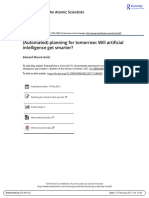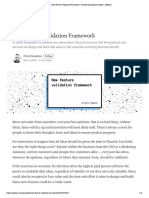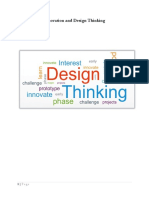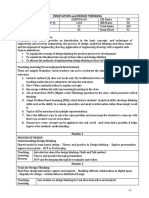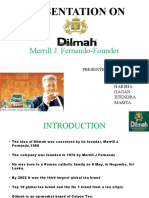Professional Documents
Culture Documents
Design Thinking: Phase I: Understanding and Empathy
Design Thinking: Phase I: Understanding and Empathy
Uploaded by
Ally Mar ZafarallaOriginal Description:
Original Title
Copyright
Available Formats
Share this document
Did you find this document useful?
Is this content inappropriate?
Report this DocumentCopyright:
Available Formats
Design Thinking: Phase I: Understanding and Empathy
Design Thinking: Phase I: Understanding and Empathy
Uploaded by
Ally Mar ZafarallaCopyright:
Available Formats
GE1715
DESIGN THINKING
The Design Thinking (DT) Process has been credited with driving innovations such as the computer mouse,
the original Palm Pilot PDA’s, and Pixar’s hit movies. DT’s proponents insist that it can even transform
organizations. Regardless of the hype, DT offers provocative ideas to use in making decisions and
managing teams.
Design Thinking is iterative, which means a person tests an assumption then returns to the prototype stage
and modifies it based on the results and feedback. Iterate to learn lessons, sooner rather than later, then
try again.
Design Thinking is a state of mind. It’s a human-centric, holistic approach to problem solving and business
thinking that employs empathy, ideation, prototyping, and experimentation to solve real-world issues. For
organizations seeped in this approach, Design Thinking works horizontally across an organization to tear
down silos, improve communications, and deliver new insights. It’s been called “the search for a magical
balance between business and art; structure and chaos; intuition and logic; concept and execution;
playfulness and formality; and, control and empowerment.” It’s been called “the glue between disciplines.”
Advantages of Design Thinking:
• It insists businesspeople to keep their focus on humans and human needs.
• It relies on both creativity and logic.
• It promotes a learn-by-doing approach and even suggests that failure is a good way to learn.
• It’s crazy collaborative.
• And it posits that the way a thing looks is not a secondary consideration; rather, things cannot function
well if they don’t appeal to our hardwired visual senses.
Phase I: Understanding and Empathy
Empathy is the centerpiece of a human-centered design process. The empathize mode is the work you do
to understand people within the context of your design challenge. It is your effort to understand the way
they do things and why, their physical and emotional needs, how they think about world, and what is
meaningful to them.
Benefits of Empathy
As a design thinker, the problems you are trying to solve are rarely your own—they are those of a
particular group of people; in order to design for them, you must gain empathy for who they are and what
is important to them.
Observing what people do and how they interact with their environment gives you clues about what they
think and feel. It also helps you learn about what they need. By watching people, you can capture physical
manifestations of their experiences – what they do and say. This will allow you to infer the intangible
meaning of those experiences in order to uncover insights. These insights give you direction to create
innovative solutions. The best solutions come out of the best insights into human behavior. But learning
to recognize those insights is harder than you might think. Why? Because our minds automatically filter
out a lot of information without us even realizing it. We need to learn to see things “with a fresh set of
eyes,” and empathizing is what gives us those new eyes.
Engaging with people directly reveals a tremendous amount about the way they think and the values they
hold. Sometimes these thoughts and values are not obvious to the people who hold them, and a good
conversation can surprise both the designer and the subject by the unanticipated insights being revealed.
The stories that people tell and the things that people say they do—even if they are different from what
they actually do—are strong indicators of their deeply held beliefs about the way the world is. Good
designs are built on a solid understanding of these beliefs and values.
10 Handout 1 *Property of STI
student.feedback@sti.edu Page 1 of 5
GE1715
How to Empathize
To empathize, you:
• Observe. View users and their behavior in the context of their lives. As much as possible, do
observations in relevant contexts alongside interviews. Some of the most powerful realizations come
from noticing a disconnect between what someone says and what s/he does. Others come from a
work-around someone has created which may be very surprising to you as the designer, but they
may not even think of bringing it up in a conversation.
• Engage. Sometimes we call this technique “interviewing” but it should really feel more of like a
conversation. Prepare some questions you’d like to ask but expect to let the conversation deviate
from them. Keep the conversation only loosely bounded. Elicit stories from the people you talk to,
and always ask “Why?” to uncover deeper meaning. Engagement can come through both short
‘intercept’ encounters and longer scheduled conversations.
• Watch and Listen. Certainly, you can – and should – combine observation and engagement. Ask
someone to show you how they complete a task. Have them physically go through the steps and talk
you through why they are doing what they do. Ask them to vocalize what’s going through their mind
as they perform a task or interact with an object. Have a conversation in the context of someone’s
home or workplace—so many stories are embodied in artifacts. Use the environment to prompt
deeper questions.
Phase II: Defining the Problem
The define mode of the design process is all about bringing clarity and focus to the design space. It is your
chance, and responsibility, as a design thinker to define the challenge you are taking on based on what you
have learned about your user and about the context. After becoming an instant-expert on the subject and
gaining invaluable empathy for the person you are designing for, this stage is about making sense of the
widespread information you have gathered.
Benefits of Defining
The define mode is critical to the design process because it results from your point-of-view (POV), which
is the explicit expression of the problem you are striving to address. More importantly, your POV defines
the RIGHT challenge(s) to address based on your new understanding of people and the problem space.
It may seem counterintuitive, but crafting a narrowed down problem statement tends to yield both greater
quantity and higher quality solutions when you are generating ideas.
The define mode is also an endeavor to synthesize your scattered findings into powerful insights. It is this
synthesis of your empathy work that gives you the advantage that no one else has: discoveries that you
can leverage to tackle the design challenge, that is, INSIGHT.
How to Define
Consider what stood out to you when talking and observing people. What patterns have emerged when
you look at the set? If you noticed something interesting, ask yourself (and your team) why that might be.
In asking why someone had a certain behavior or feeling, you are making connections from that person
to a larger context.
Develop an understanding of the type of person you are designing for, i.e., your USER. Synthesize and
select a limited set of NEEDS that you think are important to fulfill; you may, in fact, express just one (1)
salient need to address. Work to express INSIGHTS you have developed through the synthesis of
information with the help of empathy and research work. Then, establish a point-of-view by combining the
three (3) elements – user, need, and insight – as an actionable problem statement that will drive the rest
of your design work.
10 Handout 1 *Property of STI
student.feedback@sti.edu Page 2 of 5
GE1715
Phase III: Brainstorming Solutions
Ideate is the mode of the design process in which you concentrate on idea generation. Mentally, it
represents a process of “going wide” in terms of concepts and outcomes. Ideation provides both the fuel
and the source material for building prototypes and getting innovative solutions into the hands of your users.
Benefits of Brainstorming
Ideation is your chance to combine the understanding you have of the problem space, and the people
you are designing for, with your imagination to generate solution concepts. Particularly early in a design
project, ideation is about pushing for the widest possible range of ideas from which you can select, not
simply finding a single, best solution. The determination of the best solution will be discovered later
through user testing and feedback.
The various forms of ideation are leveraged to:
• Stepping beyond obvious solutions, thus increasing the innovation potential of your solution set;
• Harnessing the collective perspectives and strengths of your teams;
• Uncovering unexpected areas of exploration;
• Creating fluency (volume) and flexibility (variety) in your innovation options; and,
• Getting obvious solutions out of your heads and driving your team beyond them.
How to Brainstorm
You ideate by combining your conscious and unconscious mind and rational thoughts with imagination.
For example, in brainstorming, you leverage the synergy of the group to reach new ideas by building on
others’ ideas. Adding constraints, surrounding yourself with related materials that can inspire you or the
team, and embracing misunderstandings allow you to reach further than you could by simply thinking
about a problem.
Another ideation technique is prototyping. In physically making something, a person comes at point where
decisions need to be made. This encourages new ideas to come forward.
There are other ideation techniques such as bodystorming, mind mapping, and sketching, where the
common theme is deferring judgment – that is, separating the generation of ideas from the evaluation of
ideas. By doing so, imagination and creativity is given a voice.
Phase IV: Prototyping Solutions
The prototype mode is the iterative generation of artifacts intended to answer questions that get you closer
to your final solution. In the early stages of a project, that question may be broad like, “Will my users enjoy
cooking in a competitive manner?” In these early stages, you should create low-resolution prototypes that
are quick and cheap to make, but can elicit useful feedback from users and colleagues. (Think minutes and
cents.) In later stages, both your prototype and questions may get a little more refined. For example, you
may create a later stage prototype for the cooking project that could trickle down to, “Will my users enjoy
cooking with voice commands or visual commands?”
Benefits of Prototype
To ideate and problem-solve. Build to think.
To communicate. If a picture is worth a thousand words, a prototype is worth a thousand pictures.
To start a conversation. Your interactions with users are often richer when centered around a
conversation piece. A prototype is an opportunity to have another directed conversation with a user.
To fail quickly and cheaply. Committing as few resources as possible to each idea means less time and
money invested up front.
10 Handout 1 *Property of STI
student.feedback@sti.edu Page 3 of 5
GE1715
To test possibilities. Staying on low resolution allows you to pursue many different ideas without
committing to a direction too early on.
To manage the solution-building process. Identifying a variable also encourages you to break a large
problem down into smaller, testable chunks.
How to Prototype
Start building. Even if you aren’t sure of what you’re doing, the act of picking up some materials—post-
its, tape, and other small objects are a good way to start!—will be enough to get you going.
Don’t spend too long on one (1) prototype. Let go before you find yourself getting too emotionally
attached to one (1) prototype.
Identify a variable. Identify what’s being tested with each prototype. A prototype should answer a
particular question when tested. That said, don’t be blind to the other tangential understanding you can
gain when someone responds to a prototype.
Build with the user in mind. What do you hope to test with the user? What sorts of behavior do you
expect? Answering these questions will help focus your prototyping and help you receive meaningful
feedback in the testing phase.
Phase V: Testing the Solution
The test mode includes soliciting feedback from the prototypes given to the users. It is another opportunity
to gain empathy from the target market of the product.
Testing is another opportunity to understand your user. But unlike your initial empathy mode, you now have
likely done more framing of the problem and created prototypes to test. Both these things tend to focus the
interaction with users, but don’t reduce your “testing” to asking whether or not people like your solution.
Instead, continue to ask “Why?” and focus on what you can learn about the person, the problem, and your
potential solutions.
Ideally, you can test within a real context of the user’s life. For a physical object, ask people to take it with
them and use it within their normal routines. For an experience, try to create a scenario in a location that
would capture the real situation. If testing a prototype is not possible, frame a more realistic situation by
having the users take on a role or task when approaching your prototype. A rule of thumb: always prototype
as if you know you’re right, but test as if you know you’re wrong; testing is the chance to refine your solutions
and make them better.
Benefits of Testing the Solution
To refine prototypes and solutions. Testing informs the next iterations of prototypes. Sometimes this
means going back to the drawing board.
To learn more about your user. Testing is another opportunity to build empathy through observation
and engagement; it often yields unexpected insights.
To refine your POV. Sometimes testing reveals that not only did you get the solution wrong, but you also
failed to frame the problem correctly.
How to Test
Show; Don’t Tell. Put your prototype in the user’s hands – or your user – within an experience. And don’t
explain everything (yet). Let your tester interpret the prototype. Watch how they use (and misuse!) what
you have given them, and how they handle and interact with it; then, listen to what they say about it and
the questions they have.
Create Experiences. Create your prototypes and test them in a way that feels like an experience that
your user is reacting to, rather than an explanation that your user is evaluating.
10 Handout 1 *Property of STI
student.feedback@sti.edu Page 4 of 5
GE1715
Ask Users to Compare. Bringing multiple prototypes to the field to test gives users a basis for
comparison, and comparisons often reveal latent needs.
REFERENCES:
Moottee, I. (2013). Design thinking for strategic innovation. Hoboken, New Jersey: John Wiley & Sons.
Plattner, H. (2012). An introduction to design thinking: Process guide. Stanford, California: Institute of
Design at Stanford.
Vianna, M., Vianna, Y., Adler, I.K., Lucena, B., & Russo, B. (2012). Design thinking: Business innovation
(1st ed.). Marechal Camara, Rio de Janeiro: MJV Press.
10 Handout 1 *Property of STI
student.feedback@sti.edu Page 5 of 5
You might also like
- Redspot Past Year PapersDocument4 pagesRedspot Past Year Papersjayseth50% (2)
- Book Review of Critical ChainDocument5 pagesBook Review of Critical ChainLei ChenNo ratings yet
- KaukulanDocument2 pagesKaukulanLunilyn Ortega100% (2)
- Ai - Q - 1Document2 pagesAi - Q - 1sangram sahani0% (1)
- Professional EthicsDocument41 pagesProfessional EthicsSiti Masni AhmadNo ratings yet
- Just Us! Cafe CaseDocument8 pagesJust Us! Cafe CaseAjay Pratap SinghNo ratings yet
- Innovation Management For B&MDocument27 pagesInnovation Management For B&MEva VeyryNo ratings yet
- Automated Planning For Tomorrow AIDocument7 pagesAutomated Planning For Tomorrow AIColin LewisNo ratings yet
- The Spatial Dynamics of Shakespearean DramaDocument234 pagesThe Spatial Dynamics of Shakespearean DramaAngelica Fenech100% (2)
- Taking Responsibility Self-Reliance and The Accountable Life Nathaniel Branden 256p - 0684832488.compressedDocument264 pagesTaking Responsibility Self-Reliance and The Accountable Life Nathaniel Branden 256p - 0684832488.compressedDongkyun Hong100% (8)
- Deloitte CN MMP Pre Reading Design Thinking Participant Fy19 en 181106Document22 pagesDeloitte CN MMP Pre Reading Design Thinking Participant Fy19 en 181106Mohamed Ahmed RammadanNo ratings yet
- How Did The Great, Innovative Leaders of Our Time Become Great?Document4 pagesHow Did The Great, Innovative Leaders of Our Time Become Great?api-385479103No ratings yet
- SuccessDocument23 pagesSuccessქეთევან სულაბერიძეNo ratings yet
- Product Validation Framework - Product Management Insider - MediumDocument11 pagesProduct Validation Framework - Product Management Insider - MediumanshumanNo ratings yet
- Design Thinking Unit 1Document22 pagesDesign Thinking Unit 1akash agarwalNo ratings yet
- Managing A Successful Computing ProjectDocument78 pagesManaging A Successful Computing ProjectJunaid FarooqNo ratings yet
- Organizational BehaviorDocument2 pagesOrganizational BehaviorHuimin Chee100% (1)
- Kanban KaizenDocument28 pagesKanban KaizenPerez JoseNo ratings yet
- The Suggestion How To Manage A Perfect ProjectDocument10 pagesThe Suggestion How To Manage A Perfect ProjectAmy RahimNo ratings yet
- Chapter Two: Defining The Research Problem and Hypotheses Formulation 2.1 What Is Research Problem?Document8 pagesChapter Two: Defining The Research Problem and Hypotheses Formulation 2.1 What Is Research Problem?wubeNo ratings yet
- Design Thinker Pre-Read enDocument4 pagesDesign Thinker Pre-Read enCarlos ReyesNo ratings yet
- Strategic SourcingDocument3 pagesStrategic SourcingJeongwon Lee0% (1)
- Idt MaterialDocument39 pagesIdt MaterialPravallika ReddyNo ratings yet
- Project Scope Is A Detailed Outline of All Aspects of A ProjectDocument8 pagesProject Scope Is A Detailed Outline of All Aspects of A ProjectCollins AbereNo ratings yet
- Value Stream MappingDocument33 pagesValue Stream Mappingwaqasalitunio100% (2)
- Big Think StrategyDocument13 pagesBig Think StrategyXU BeckyNo ratings yet
- Solvancy and Liquidity RatioDocument45 pagesSolvancy and Liquidity RatioRitesh AnandNo ratings yet
- Problem - Solution Fit Template v1Document1 pageProblem - Solution Fit Template v1VINAYAK SIVANo ratings yet
- Personal Balanced Scorecard - Principles of ManagementDocument10 pagesPersonal Balanced Scorecard - Principles of ManagementEvangelos ThianiNo ratings yet
- GROUP 3 - Pablo Gil - Case Study 1Document12 pagesGROUP 3 - Pablo Gil - Case Study 1Pablo GilNo ratings yet
- Interaction Design Lab - Week 01Document19 pagesInteraction Design Lab - Week 01Kim LongNo ratings yet
- Innovation and Design Thinking: I SemesterDocument4 pagesInnovation and Design Thinking: I Semestergreeshma100% (1)
- Designin HealthcareDocument16 pagesDesignin HealthcareDikshita PantNo ratings yet
- WhitePaper GuidedIdeation Hemre PDFDocument8 pagesWhitePaper GuidedIdeation Hemre PDFArslan Yaris100% (1)
- Design Thinking and Transformation LeadershipDocument22 pagesDesign Thinking and Transformation LeadershipEregamani DinamaniNo ratings yet
- Mindful Productivity Audit Ness Labs UpdatedDocument9 pagesMindful Productivity Audit Ness Labs UpdatedjoNo ratings yet
- New Product Development StrategyDocument10 pagesNew Product Development StrategyJitendra BagalNo ratings yet
- Design ResearchDocument20 pagesDesign ResearchFadhilah Khairatun HisanNo ratings yet
- Soft Skill TrainingDocument4 pagesSoft Skill TrainingDeepak AgarwalNo ratings yet
- Submitted By: Preeti Submitted To: Prof - Tejinder ROLL NO: 18010 Class: Mcom 1StDocument16 pagesSubmitted By: Preeti Submitted To: Prof - Tejinder ROLL NO: 18010 Class: Mcom 1StPreeti100% (1)
- Innovation and Creativity Lec TwoDocument14 pagesInnovation and Creativity Lec TwobenNo ratings yet
- Innovation & Stages of Successful Innovation: InnovationDocument3 pagesInnovation & Stages of Successful Innovation: Innovationshahryar khanNo ratings yet
- Working Backwards Amazons Approach To Innovation INO206Document19 pagesWorking Backwards Amazons Approach To Innovation INO206محمد خالد100% (1)
- The Guiding Principles of The Product Planning Process by ProductPlanDocument31 pagesThe Guiding Principles of The Product Planning Process by ProductPlanTony Espinosa AtocheNo ratings yet
- Innovation ManagementDocument123 pagesInnovation ManagementAnil Thomson100% (1)
- Design ThinkingDocument29 pagesDesign Thinkingsinghsaurabhh91No ratings yet
- Vision: The Broadest View: That Which You Strive ForDocument9 pagesVision: The Broadest View: That Which You Strive ForDavid Bozin0% (1)
- Creative Thinking: 1. Open The FloodgatesDocument4 pagesCreative Thinking: 1. Open The FloodgatesAnnelies PoppeNo ratings yet
- The Organizational Structure of InnovationDocument4 pagesThe Organizational Structure of InnovationPaul SunNo ratings yet
- Innovation and Imagination at WorkDocument417 pagesInnovation and Imagination at WorkClei BorgiaNo ratings yet
- Business Impact Through Strategic DesignDocument7 pagesBusiness Impact Through Strategic DesignAfshan HameedNo ratings yet
- Summary of Josh Anon & Carlos González de Villaumbrosia's The Product BookFrom EverandSummary of Josh Anon & Carlos González de Villaumbrosia's The Product BookNo ratings yet
- Creativity & Innovation in Organizations - MV190713Document14 pagesCreativity & Innovation in Organizations - MV190713(unknown)No ratings yet
- Innovation StrategyDocument17 pagesInnovation Strategymurary1230% (1)
- Systematic Literature ReviewDocument16 pagesSystematic Literature ReviewSheetal MaviNo ratings yet
- Britvic PLCDocument17 pagesBritvic PLCMuhammad Ramiz Amin0% (1)
- Lesson 7 Creativity and Innovation: StructureDocument23 pagesLesson 7 Creativity and Innovation: StructureVikash KumarNo ratings yet
- Recruitment & Selection Process of BAT BangladeshDocument12 pagesRecruitment & Selection Process of BAT BangladeshLove BirdNo ratings yet
- Introduction To Entrepreneurship: Prepared For Class Discussion by Prof.S.SuryanarayananDocument10 pagesIntroduction To Entrepreneurship: Prepared For Class Discussion by Prof.S.SuryanarayananPrajakt WaleNo ratings yet
- MDT Report FormDocument4 pagesMDT Report Formapi-250168703No ratings yet
- Examples of Business Model Canvas For Small Business SetupDocument4 pagesExamples of Business Model Canvas For Small Business SetupMahesh GajjelliNo ratings yet
- Topic 1 Overview of Intelligent SystemsDocument35 pagesTopic 1 Overview of Intelligent SystemsPurvi ChaurasiaNo ratings yet
- Design Thinking WorkshopDocument15 pagesDesign Thinking Workshopeduardo jmsantosNo ratings yet
- Flowershop WebsiteDocument12 pagesFlowershop WebsiteEmmanuel DavidNo ratings yet
- How to Identify Business Opportunities and Make the Most of ThemFrom EverandHow to Identify Business Opportunities and Make the Most of ThemNo ratings yet
- Sorry, I'm Not Taking This TestDocument10 pagesSorry, I'm Not Taking This TestEmma BarnhartNo ratings yet
- 1.0 Basic Features of Sarva Shiksha AbhiyanDocument2 pages1.0 Basic Features of Sarva Shiksha AbhiyantkkorNo ratings yet
- Cultural Stereotypes and Their FunctionsDocument11 pagesCultural Stereotypes and Their FunctionsАнна РибакNo ratings yet
- Project Report OnDocument10 pagesProject Report Onfaisal9900660% (1)
- Second Lesson 8 MarDocument3 pagesSecond Lesson 8 Marapi-309232842No ratings yet
- Validity in Research 1: KM-Daytner@wiu - EduDocument16 pagesValidity in Research 1: KM-Daytner@wiu - EduRAIZA CANILLASNo ratings yet
- NURS FPX 6105 Assessment 3 Teaching StrategiesDocument5 pagesNURS FPX 6105 Assessment 3 Teaching Strategiesfarwaamjad771No ratings yet
- Riph Lesson 1Document3 pagesRiph Lesson 1Skyler FaithNo ratings yet
- Aztec SourcesDocument9 pagesAztec SourcesAlaina DauscherNo ratings yet
- Building AAC ToolkitDocument54 pagesBuilding AAC Toolkitelisa.dreosto1228No ratings yet
- Five SensesDocument8 pagesFive Senseslady ann jimenezNo ratings yet
- PattrensDocument2 pagesPattrensapi-296883317No ratings yet
- Fused Curriculum Gives Emphasis On The Integration of The Related Subject Only - Docx-1149815589Document40 pagesFused Curriculum Gives Emphasis On The Integration of The Related Subject Only - Docx-1149815589erlynmacenas100% (3)
- About MHRDDocument2 pagesAbout MHRDSanthanu Surendran100% (1)
- Dilmah Gagan FinalDocument11 pagesDilmah Gagan FinalgaganNo ratings yet
- Exploration: 3.1. CrystallizingDocument6 pagesExploration: 3.1. CrystallizingTạ Nam BìnhNo ratings yet
- Course Project - EDUC6230 The Teacher and The Community, School Culture and Organizational LeadershipDocument2 pagesCourse Project - EDUC6230 The Teacher and The Community, School Culture and Organizational LeadershipRoberto IgnacioNo ratings yet
- Photo Essay RubricDocument3 pagesPhoto Essay RubricgraceNo ratings yet
- Music 5 Week1 LessonPlanDocument3 pagesMusic 5 Week1 LessonPlanDupitas, Paula Janine I.No ratings yet
- Cefr LP Year 4 Language AwarenessDocument2 pagesCefr LP Year 4 Language AwarenessVijaya Malar GunushakranNo ratings yet
- Rubric - Na Poster BoardDocument1 pageRubric - Na Poster Boardapi-368307001No ratings yet
- When Do We Use KNN Algorithm?Document7 pagesWhen Do We Use KNN Algorithm?reshma acharyaNo ratings yet
- Issue-Based Work Planning and Hypothesis Problem SolvingDocument13 pagesIssue-Based Work Planning and Hypothesis Problem SolvingSTRATICXNo ratings yet
- Topic Guide 2 2018Document14 pagesTopic Guide 2 2018Lila EsauNo ratings yet







